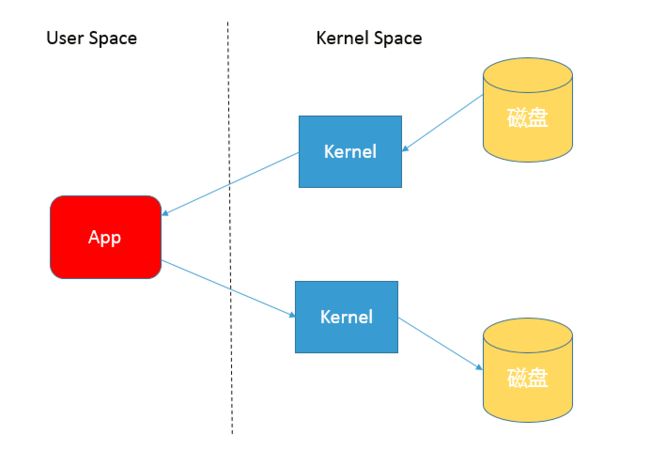使用输入输出流进行读写时,实际上是进行了多次上下文切换,比如应用读取数据时,先在内核态讲数据从磁盘读取到内核缓存,再切换到用户态将数据从内核缓存读取到用户缓存。
NIO transferTo的实现方式,在Linux和Unix上,会使用零拷贝技术,数据传输并不需要用户态参与,省去了上下午切换的开销和不必要的内存拷贝,进而可提高应用拷贝性能。
buffer是NIO操作数据的基本工具,java为每种数据类型都提供了相应的buffer实现(布尔除外)
Buffer 有几个基本属性:
capcity:它反映这个buffer到底多大,也就是数据长度
postion:要操作的数据起始位置
limit:相当于操作的限额,在读取或者写入时,limit 的意义很明显是不一样的。比如,读取操作时,很可能将 limit 设置到所容纳数据的上限;而在写入时,则会设置容量或容量以下的可写限度。
mark,记录上一次postion的位置,默认是0
总结
如何提高类似拷贝等IO操作的性能原则:
1、合理使用缓存等机制,减少IO次数;
2、使用transferTo等机制,减少上下文切换和额外IO操作;
3、尽量减少不必要的转换过程,比如编解码;对象序列化和反序列化,比如操作文本文件或者网络通信,如果不是过程中需要使用文本信息,可以考虑不要将二进制信息转换成字符串,直接传输二进制信息
/**
* This file created at 2018年10月29日.
*/
package io;
import java.io.File;
import java.io.FileInputStream;
import java.io.FileOutputStream;
import java.io.IOException;
import java.io.InputStream;
import java.io.OutputStream;
import java.nio.channels.FileChannel;
import java.nio.file.Files;
import org.apache.commons.io.FileUtils;
/**
*
{@link MAIN}*
* TODO : document me
*
* @author yabushan
*/
public class MAIN {
public static void main(String[] args) throws IOException {
copyFileUsingFileStreams(new File("D:/表结构.xlsx"), new File("D:/表结构2.xlsx"));
copyFileUsingFileChannels(new File("D:/表结构.xlsx"), new File("D:/表结构3.xlsx"));
copyFileUsingApacheCommonsIO(new File("D:/表结构.xlsx"), new File("D:/表结构4.xlsx"));
copyFileByChannel(new File("D:/表结构.xlsx"), new File("D:/表结构5.xlsx"));
}
/**
* 1. 使用FileStreams复制
* 这是最经典的方式将一个文件的内容复制到另一个文件中。
* 使用FileInputStream读取文件A的字节,使用FileOutputStream写入到文件B
* @param source
* @param dest
* @throws IOException
*/
private static void copyFileUsingFileStreams(File source, File dest)
throws IOException {
InputStream input = null;
OutputStream output = null;
try {
input = new FileInputStream(source);
output = new FileOutputStream(dest);
byte[] buf = new byte[1024];
int bytesRead;
while ((bytesRead = input.read(buf)) > 0) {
output.write(buf, 0, bytesRead);
}
} finally {
input.close();
output.close();
}
}
/**
*
* 2. 使用FileChannel复制
* Java NIO包括transferFrom方法,根据文档应该比文件流复制的速度更快
* * @param source
* @param dest
* @throws IOException
*/
private static void copyFileUsingFileChannels(File source, File dest)
throws IOException {
FileChannel inputChannel = null;
FileChannel outputChannel = null;
try {
inputChannel = new FileInputStream(source).getChannel();
outputChannel = new FileOutputStream(dest).getChannel();
outputChannel.transferFrom(inputChannel, 0, inputChannel.size());
} finally {
inputChannel.close();
outputChannel.close();
}
}
/**
* 3. 使用Commons IO复制
* Apache Commons IO提供拷贝文件方法在其FileUtils类,
*可用于复制一个文件到另一个地方。
*它非常方便使用Apache Commons FileUtils类时,您已经使用您的项目。
*基本上,这个类使用Java NIO FileChannel内部
* @param source
* @param dest
* @throws IOException
*/
private static void copyFileUsingApacheCommonsIO(File source, File dest)
throws IOException {
FileUtils.copyFile(source, dest);
}
/**
* 4. 使用Java7的Files类复制
* 如果你有一些经验在Java 7中你可能会知道,
* 可以使用复制方法的Files类文件,从一个文件复制到另一个文件
* @param source
* @param dest
* @throws IOException
*/
private static void copyFileUsingJava7Files(File source, File dest)
throws IOException {
Files.copy(source.toPath(), dest.toPath());
}
/**
* 利用java.nio类库提供的transferTo或transferFrom方法实现
* @param source
* @param target
* @throws IOException
*/
public static void copyFileByChannel(File source, File target) throws IOException {
try (FileChannel sc = new FileInputStream(source).getChannel();
FileChannel tc = new FileOutputStream(target).getChannel();) {
long count = sc.size();
while (count > 0) {
long transferred = sc.transferTo(sc.position(), count, tc);
count -= transferred;
}
}
}
}


